
On a hot summer afternoon, we didn’t need much more than the shade of a mimosa tree and a watermelon to stay cool. My grandfather would split one open, spear the flesh with his fingers, and pull out a chunk. We ate it with our hands and weren’t afraid to make a mess. Watermelon and I were a love match made in heaven—literally it turns out. Little did I know then that I would grow up to marry a watermelon farmer whose family has grown the fruits for the past 90 years.
Though it would be easy enough to bring home watermelons from the field, we enjoy growing them in the garden beside the house. Breeding has reduced watermelons’ demand for luxury berths in the garden. As you will see, they can even be trellised. When you pick and eat a perfectly ripe watermelon from your own garden, you will understand the meaning of home-grown fun.
The origins of the watermelon
|
Finding time and space
No getting around it, the 25-lb. behemoths such as ‘Crimson Sweet’, a round, red-fleshed melon with dark green stripes, and ‘Royal Majesty’, also red-fleshed but oblong, require 6 ft. by 4 ft. garden plots for each plant.
On the other hand, icebox watermelons such as ‘Sugar Baby’, a round, red-fleshed fruit with a very dark green skin, and ‘Yellow Doll’, with its namesake flesh and light green skin, are perfectly suited for small gardens. They’ll do fine with 2 ft. by 4 ft. spaces per plant and turn out fruits of 5 lb. to 18 lb.

You can tighten the quarters a bit more with a bush type watermelon, such as ‘Garden Baby’. These compact vines require just a 2 ft. by 2 ft. spot and can even be grown in a large container on a patio.
Although a warm-climate crop, watermelons can be grown in northern areas if you have the right variety. Icebox types like ‘Sugar Baby’, ‘Yellow Doll’, ‘Tiger Baby’, and ‘Garden Baby’ mature in 75 to 85 days, which should be enough time for a bountiful harvest. The larger watermelons typically take 85 to 95 days to mature. On the Delmarva peninsula, we begin picking watermelons around July 4 and continue through early to mid-September, harvesting two or three fruits per plant. But it won’t pay to rush watermelon seed into the ground when it’s cool. The plants will just idle until warm weather arrives.
Get fruit faster with transplants
Sources For Watermelon Seed
|
Transplants are great because the plants will bear watermelons about a week sooner than their direct-seeded counterparts. Start seeds four weeks before you plan to plant in the garden. Many types of containers work, as long as they have good drainage. Those that are 2 in. across are ideal and produce well-rooted seedlings that will take off after transplanting.
Watermelon seed germinates well at temperatures of 70˚ to 95˚F and takes four to six days to emerge. Harden off transplants by reducing the frequency of watering to slow growth, and move the plants to an area with cooler temperatures for about a week. Transplants ready for the garden will be 4 in. to 5 in. tall, with two or three true leaves. Set them out in well-drained soil. Watermelon plants don’t like “wet feet” and are great candidates for raised beds.
Seedless fruits take special effort. Seedless watermelons, which, despite the name, do contain soft, white seeds, don’t produce their own pollen. They require the company of a pollenizer, which can be any seeded variety. Every third plant in a row of seedless watermelons should be a seeded variety. Choose a pollenizer with different surface markings so it’s easier to tell at picking time which have seeds and which do not.
With seedless varieties, I especially prefer transplants. The seeds are expensive, 15 cents to 17 cents each, and they are fussy about germinating. The seed coat tends to adhere to the cotyledons and needs to be removed so growth isn’t hindered. Whatever extra work is involved, though, is worth it to me because I love the taste of these melons and I don’t have to pick out the seeds for my children.
Proper nutrition depends on watering
Watermelons need steady watering throughout the season, at least 1 in. per week. Blossom end rot, caused by a calcium deficiency during fruit development, can be a problem. Maintaining the proper soil moisture makes calcium available when it’s needed.
Watermelons are heavy feeders and may need a boost for good growth if you don’t have rich soil. Laying down 3 lb. of 10-10-10 fertilizer or the organic equivalent per 100 sq. ft. just prior to planting would not be out of line. A little side dressing when the vines begin to run and a little more after the first fruit is harvested may be in order as well.
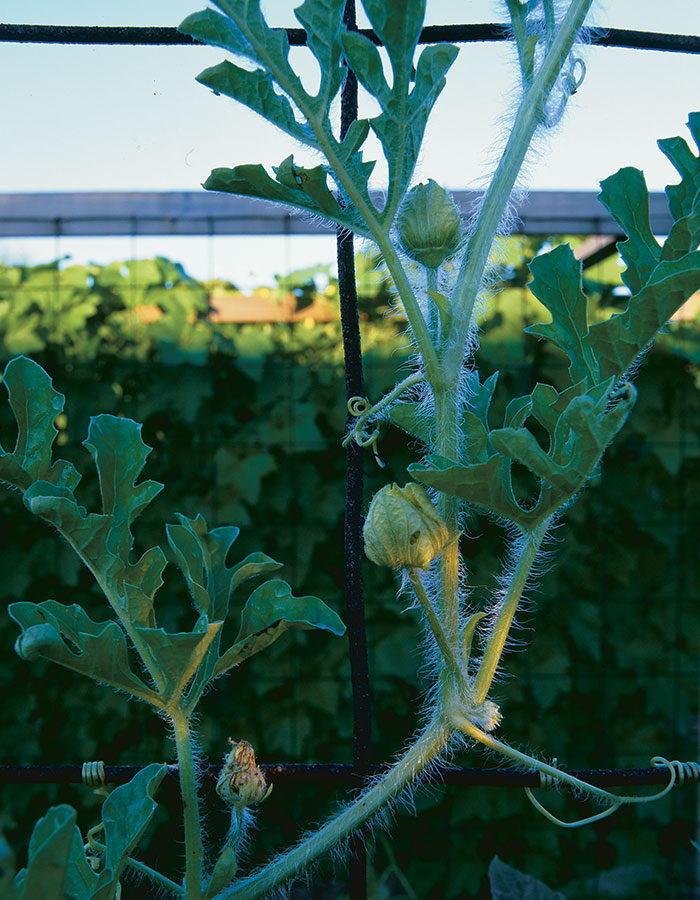
Even heavyweights face attacks. The best defense against watermelon woes, such as gummy stem blight, is planting disease-resistant varieties, rotating crops, and spacing plants to permit good air circulation.
Don’t mistake a yellow patch on the top of the melon for disease. It’s sunburn, and if you see it, just cover the fruit with a basket or cloth.
As for insects, keep an eye out for cucumber beetles. They do the most damage early in the season when plants are young and susceptible.
Halos for WatermelonsWhence watermelons came remains a botanical conundrum. Southern Italy, the source of so much good eating, enjoyed for a time the status of chief suspect as the original home. The case could not be closed because the region harbored no wild watermelon plants. In 1850, explorer David Livingstone called attention to Africa by reporting a great oasis of wild watermelons in the Kalahari Desert. Claims from other regions can be found as well, though most sources point to Africa first. Origins aside, these wet and weighty fruits have been borne across the continents and seas, with good reason. Mark Twain proffered a fine line for the fruit’s star-spangled popularity. “When one has tasted it, he knows what the angels eat.” |
Pull watermelons out of thin air
If you’re wondering what you’d have to push out of your garden to make room for watermelons, don’t despair. All you need to do is train your watermelons to climb. As the vines, which should be about two feet apart, begin to run, send them up a sturdy trellis. You will need to tie the runners to the trellis, since watermelons are not natural climbers.
Once the plants set fruit, support the burgeoning melons with slings, which can be made with cheesecloth, nylon stockings, or old T-shirts. If the sling completely covers the fruit, it provides protection from insects. In addition to saving space, trellising improves air circulation and helps prevent disease.
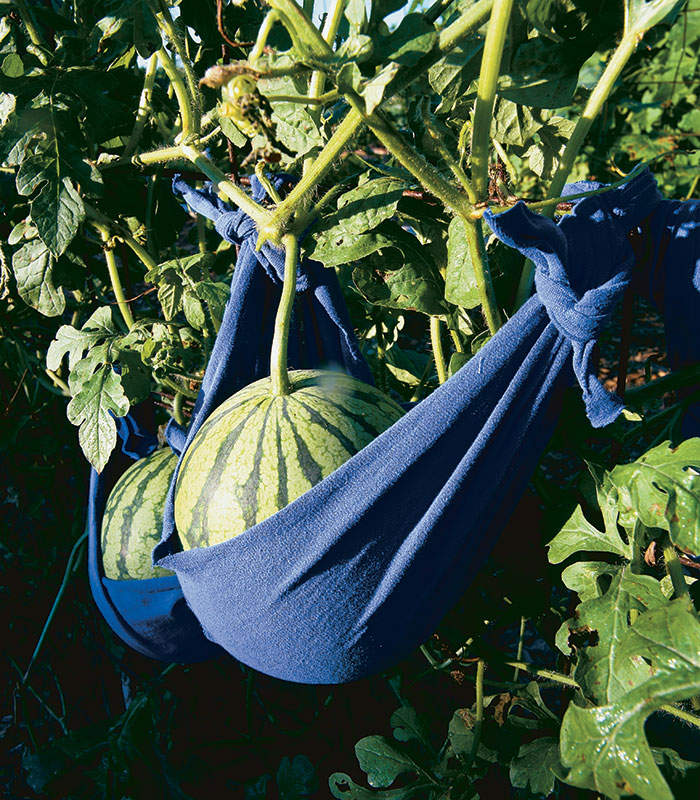
Of course, trellising requires more work than just letting the vines run over the ground. And the flowers of trellised plants are more prone to drop in a stiff wind before the fruit sets. But if you’re up for a challenge, or stymied over how to upstage the neighbors’ tomatoes, harvesting a trellised watermelon may be just the trick.
Tips for growing watermelon
 •Watermelons grow best in well-drained soil with a pH of 6.0 to 6.8. |
How to tell when they’re ready
Although determining the optimum maturity of a watermelon can be difficult, the plant provides clues. First, inspect the curly tendril near where the watermelon attaches at the stem. It should be dead or brown.
Second, turn the melon on its side and inspect the belly. The underside of the watermelon should be creamy-white for seeded varieties and golden yellow for seedless varieties.
Third, thump. A ripe melon should deliver a deep, low-pitched sound. This has always been a popular way to detect ripeness, but I have found it takes a lot of experience to truly tell the right sound.

And finally, if you’ll notice, watermelons have a shiny, bright green color on the outside as they grow. When the watermelon matures, this coloring will dull. This method of determining ripeness also takes practice, and it amazes me to watch my father-in-law harvest watermelons. He can stand at a distance and tell you if the watermelon is ripe or not. He teases me because, although I have had quite a bit of experience harvesting, I still check for the brown tendril and the color of the belly to be sure it’s ready.
—Tracy Wootten of Galestown, Maryland, is an agricultural researcher at the University of Delaware.
Photo/Illustration: Andre Baranowski.
From Kitchen Gardener #16
Learn more:
Video: How to Pick a Ripe Watermelon
Make Room for ‘Moon and Stars’…
Fine Gardening Recommended Products

Hasegawa Tripod Ladder
Fine Gardening receives a commission for items purchased through links on this site, including Amazon Associates and other affiliate advertising programs.

A.M. Leonard Deluxe Soil Knife & Leather Sheath Combo
Fine Gardening receives a commission for items purchased through links on this site, including Amazon Associates and other affiliate advertising programs.

Razor-Back Potato/Refuse Hook
Fine Gardening receives a commission for items purchased through links on this site, including Amazon Associates and other affiliate advertising programs.

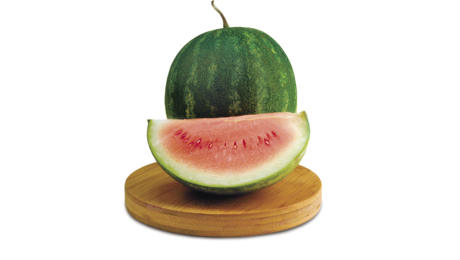
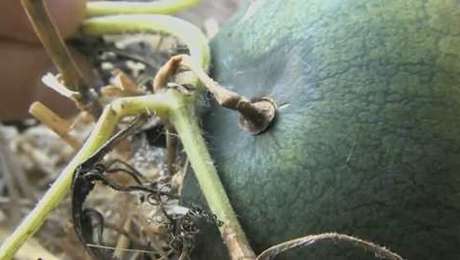
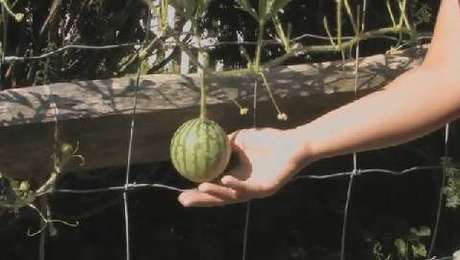
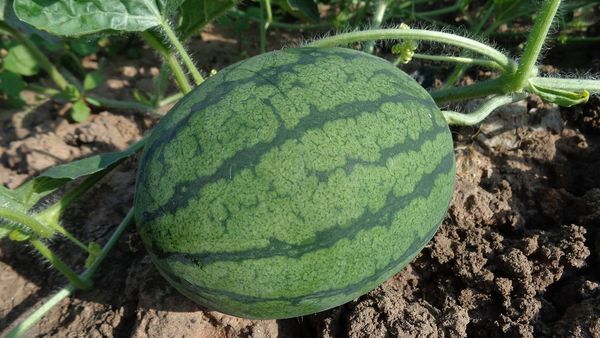













Comments
Log in or create an account to post a comment.
Sign up Log in